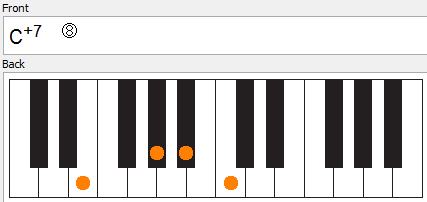Is there a simpler way to refer to this chord?
4 Answers
Another possibility (and my preference) would be C7+5. (Or C7♯5, as discussed in the comments.)
This way we clearly see that the chord is based off of a dominant C7: C E G B♭. It's fairly common to alter dominant chords in various ways, so the +5 just indicates that the chordal fifth of the C7 (G) is raised to G♯. You could also have C7♭5 which would be C E G♭ B♭.
Regarding the E in the bass, I'd recommend just using slash notation: chord, slash, bass pitch. So here I'd write C7+5/E. You could also use figured bass, but I think slash notation probably fits this repertoire better.
-
From my experience, when someone spells the chord like you suggested (with the 5th alteration after the 7th), it would be
C7 #5instead of+5Commented Jul 13, 2016 at 8:35 -
-
What's a choral fifth - is it another appellation of perfect? I agree with Shev. that #5 is a more common approach.– TimCommented Jul 13, 2016 at 8:39
-
-
There's the 'dominant 7th' chord type, and there's the actual dominant of the key you're in. Make sure you know which one you're talking about.– LaurenceCommented Apr 25, 2017 at 15:39
No. It's already shorthand.Nomeclature for chords has been established for a very long time now, and is pretty well universally accepted.
The + sign means the 5th of a chord is played one semitone higher than P5.
The 7 sign means include the b7 note. As it's written, it could nearly be construed that the 7 part is augmented, but with experience, one would realise that wouldn't make sense. Any possible ambiguity would be alleviated by writing C7+.
This example is more clearly written C+7/E, or C7+/E, as it's in 1st inversion, with C at the top, rather than bottom.
The only part of chord writing I'm not happy about is the use of '-' for minor. It's quite tiny, and especially in hand-written music, can be overlooked. You'd almost think that if '+' is augmented, then '-' should be diminished, but that's been given the symbol 'o', not to be confused with 0,for m7b5.Drat, that 'crossed out 0' appeared on screen, but not on site! Help, someone with theta!
I'm not sure there's anything simpler. It's a C augmented with an added seventh in first inversion. C+ is often used of augmented and the 7 is added. However, as augmented chords are not that common, I'd probably write C+m7/E as I'm not sure which seventh is the default for augmented chords and nothing the C+7 indicates an inversion. Had I seen a C+7 in a lead sheet, I'd play C-E-G#-Bb rather than E-G#-Bb-C.
In most music I'm familiar with, things like this are not usually chords as such; rather they occur as a confluence of voices. Notation of such note groups can be ambiguous; the above could be E+add4 just as well.
-
E+add4 would be E,G#,B#,A. The Bb has gone missing. Aug. chords with a 7th, it's usually b7 (m7).– TimCommented Jul 13, 2016 at 5:38
-
C+7is a pretty common chord in jazz songs, and it is usually spelled as such Commented Jul 13, 2016 at 8:30
No, that's as simple as it gets. It's fine for a right-hand chord. If this is ALL that's being played (no LH, no bass instrument) it might need to be more complicated. The fact that it's a first inversion might matter. So call it C7+/E.
People will enjoy themselves inventing alternative esoteric chords that these notes just might form. Tell them how clever they are, but ignore :-)


C+ 7or about what that notation means? The title and the body of your question are two different things